1993 CHEVROLET LUMINA brakes
[x] Cancel search: brakesPage 11 of 324

Downloaded from www.Manualslib.com manuals search engine These symbols are on some of your
controls:
Windshield Wipers
Windshield Washer
Windshield Defroster
Rear Window Defogger Ventilating Fan
Power Window
These symbols are used on warning and
indicator lights:
Engine Coolant
Temperature
'*Yi Battery Charging
Q I System
Engine Oil Pressure
3f
Brake
Anti-Lock Brakes
Here are some other symbols you may
see:
Fuse
Trunk Release
Lighter
Horn Speaker
Hood Release
Page 62 of 324
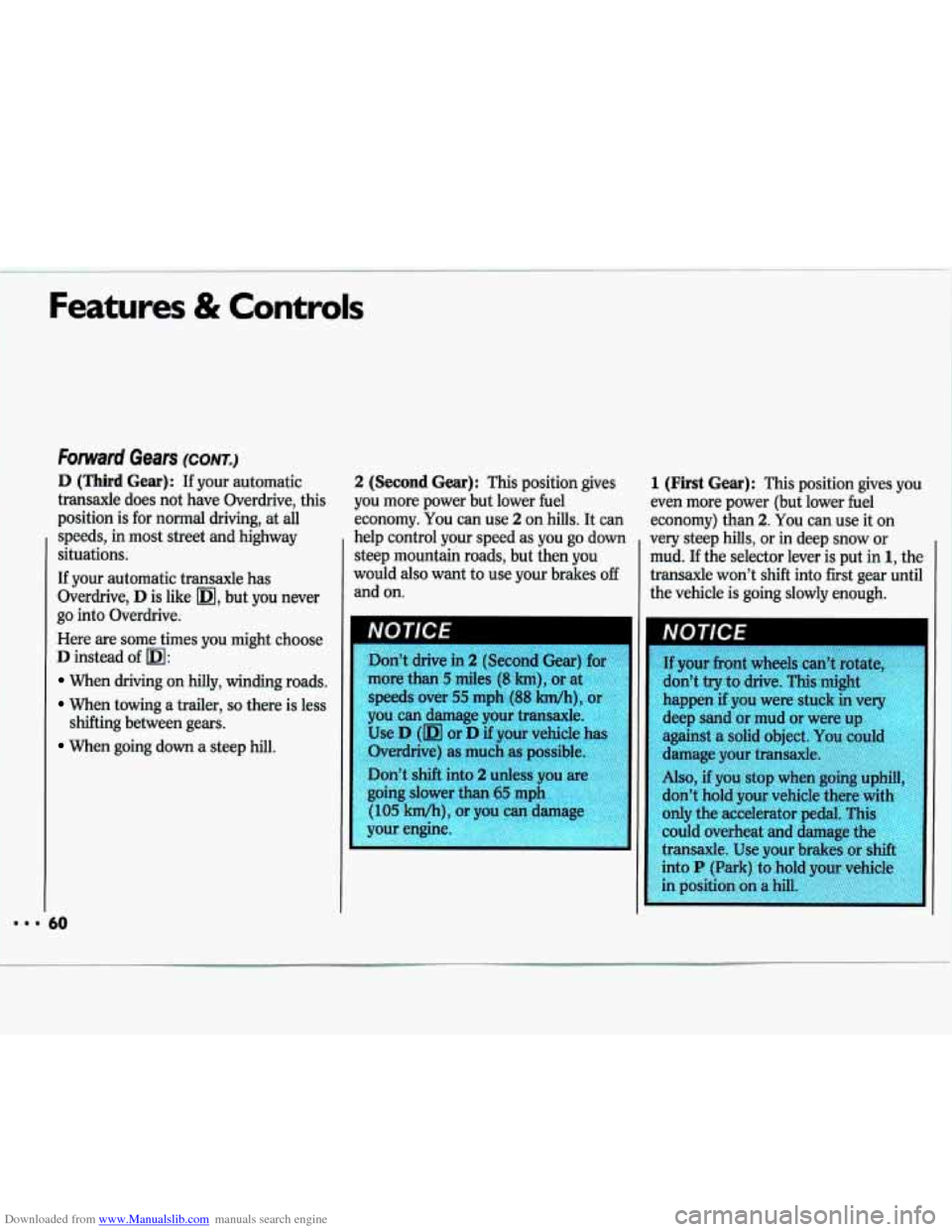
Downloaded from www.Manualslib.com manuals search engine ...
Features & Controls
Forward Gears (CONT.)
D (Third Gear): If your automatic
transaxle does not have Overdrive, this
position is for normal driving, at
all
speeds, in most street and highway
situations.
If your automatic transaxle has
Overdrive,
D is like m, but you never
go into Overdrive.
Here are some times
you might choose
D instead of m:
When driving on hilly, winding roads.
When towing a trailer, so there is less
When going down a steep hill.
shifting between gears.
50
2 (Second Gear): This position
gives
you more power but lower fuel
economy.
You can use 2 on hills. It can
help control your speed
as you go down
steep mountain roads, but then
you
would also want to use your brakes off
and on.
Don’t drive in
2 (Second Gear) for
more than
5 miles (8 km), or at
speeds over
55 mph (88 Mh), or
you can damage your transaxle.
Use
D (m or D if your vehicle has
Overdrive) as much as possible.
Don’t shift into
2 unless you are
going slower than
65 mph
(105 kwh), or you can damage
your engine.
1 (First Gear): This position gives you
even more power (but lower fuel
economy) than
2. You can use it on
very steep hills, or in deep snow
or
mud. If the selector lever is put in 1, the
transaxle won’t shift into first gear until
the vehicle is going slowly enough.
Page 65 of 324
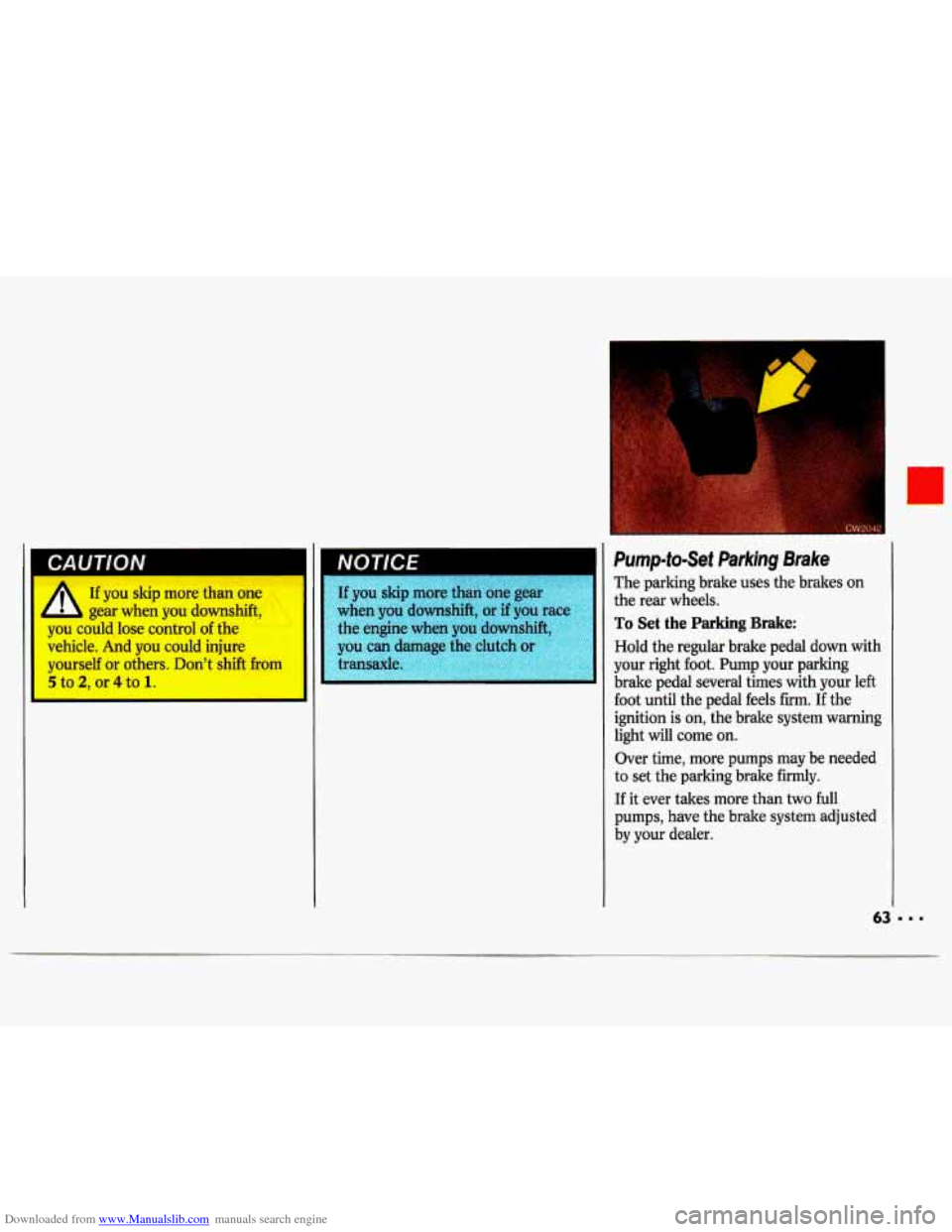
Downloaded from www.Manualslib.com manuals search engine CAUTION I
A
If you skip more than one
gear when you downshift,
you could lose control of the
vehicle. And you could injure
yourself or others. Don’t shift from
5 to 2, or 4 to 1.
I
transaxle.
Pump-to-Set Parking Brake
The parking brake uses the brakes on
the rear wheels.
To Set the Parking Brake:
Hold the regular brake pedal down with
your right
foot. Pump your parking
brake pedal several times with your left
foot until the pedal feels firm. If the
ignition is on, the brake system warning
light will come
on.
Over time, more pumps may be needed
to set the parking brake firmly.
If it ever takes more than two full
pumps, have the brake system adjusted
by your dealer.
Page 73 of 324
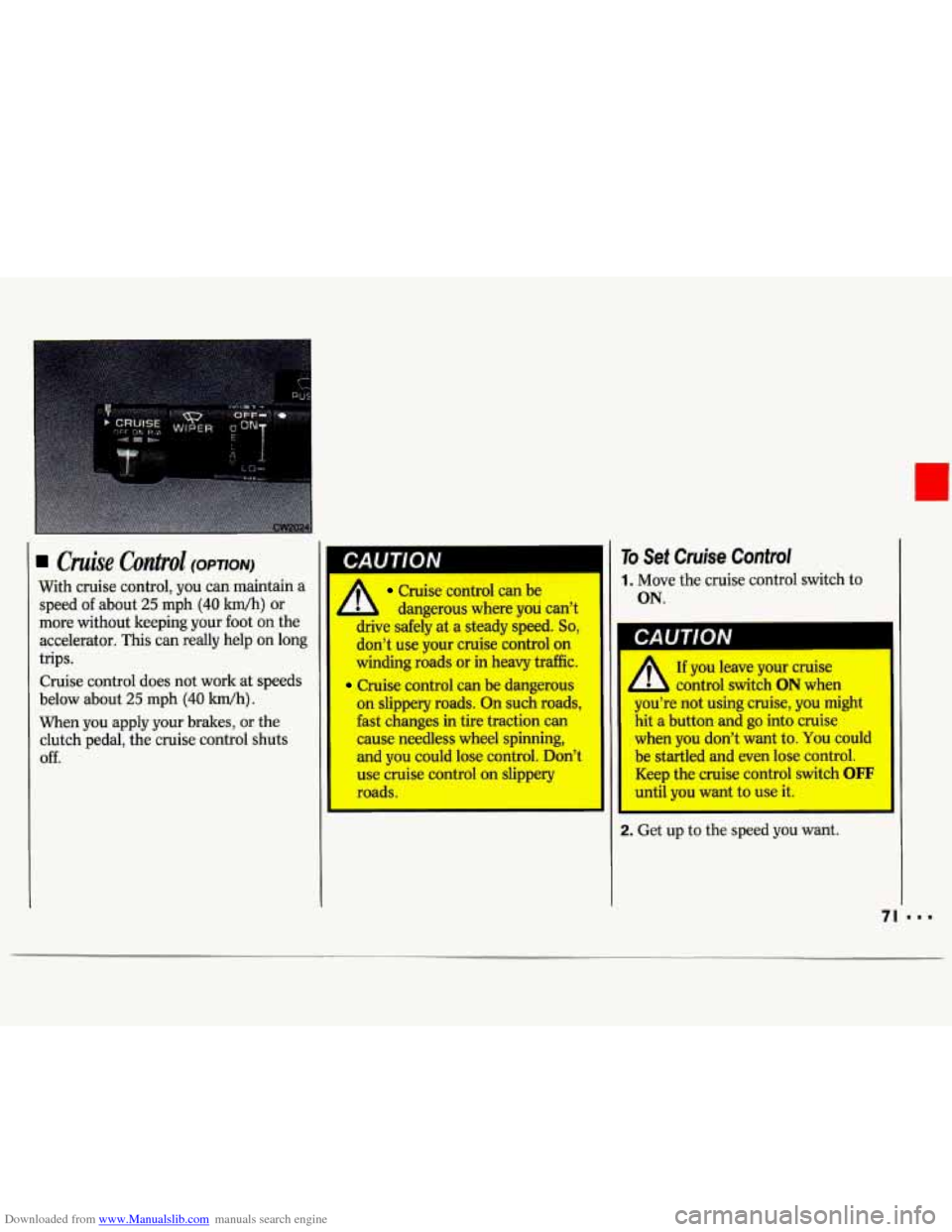
Downloaded from www.Manualslib.com manuals search engine Cruise Control (OPTION)
With cruise control, you can maintain a
speed of about 25 mph
(40 km/h) or
more without keeping your foot on the
accelerator.
This can really help on long
trips.
Cruise control does not work
at speeds
below about 25 mph
(40 lun/h).
When you apply your brakes, or the
clutch pedal, the cruise control shuts
Off.
I w
CAUTION
A dangerous where you can’t
Cruise control can be
drive safely at
a steady speed. So,
don’t use your cruise control on
winding roads or in heavy traffic.
Cruise control can be dangerous
on slippery roads. On such roads,
fast changes in tire traction can
cause needless wheel spinning,
and
you could lose control. Don’t
use cruise control on slippery
roads.
To Set Cruise Control
I. Move the cruise control switch
ON.
to
CAUTION
A If you leave your cruise
- control switch ON when
you’re not using cruise, you might
hit
a button and go into cruise
when you don’t want to.
You could
be startled and even lose control.
Keep the cruise control switch
OFF
until you want to use it.
2. Get up to the speed you want.
Page 95 of 324
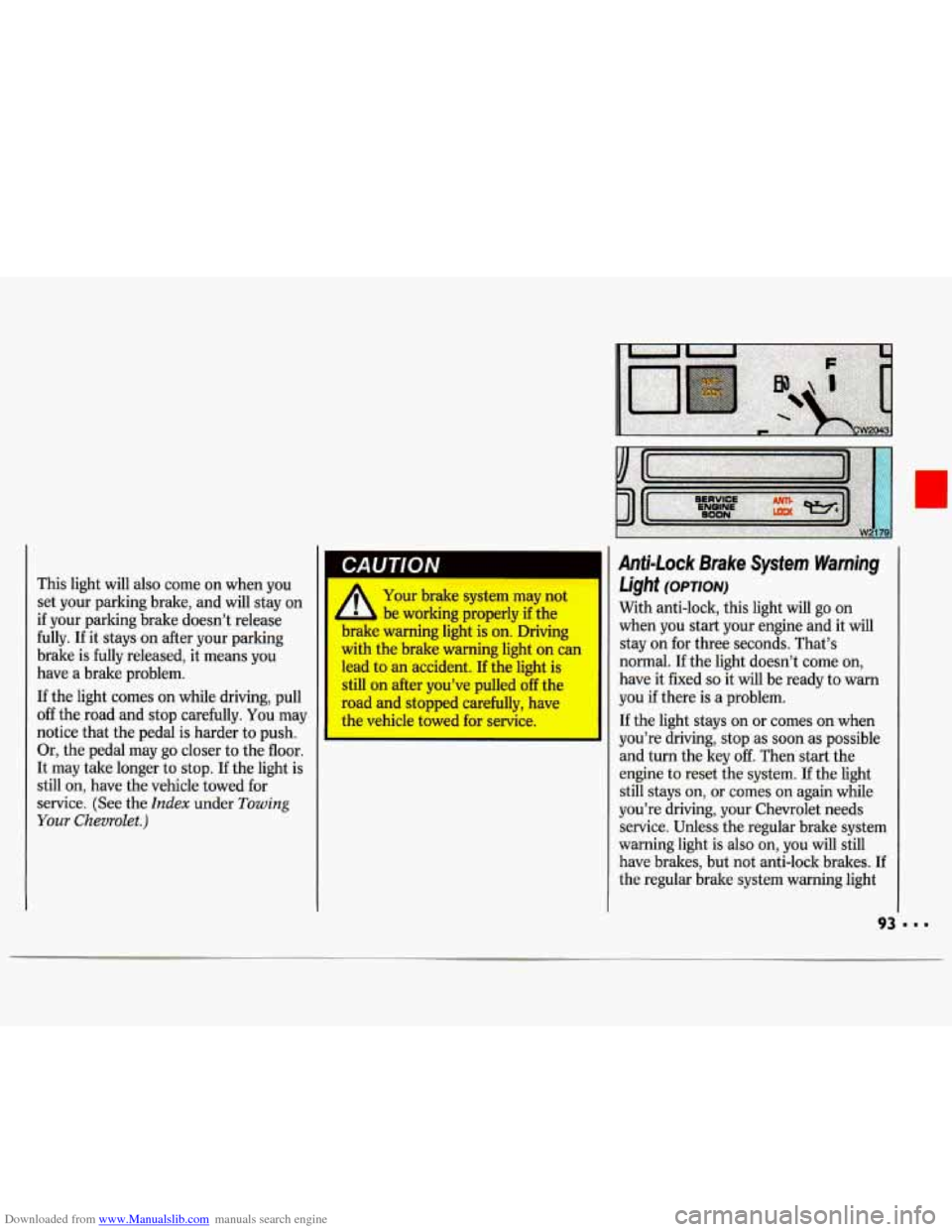
Downloaded from www.Manualslib.com manuals search engine This light will also come on when you
set your parking brake, and
will stay on
if your parking brake doesn’t release
fully. If it stays on after your parking
brake is fully released, it means you
have a brake problem.
If the light comes on while driving, pull
off the road and stop carefully. You may
notice that the pedal is harder to push.
Or, the pedal may go closer to the floor.
It may take longer to stop.
If the light is
still on, have the vehicle towed for
service. (See the
Index under Towing
Your Chevrolet.)
-
gu1/QIv ,1
A Your brake system may not ’ ‘ be working properly if the
LJlimt; warning light is on. Driving
with the brake warning light on can
lead to an accident. If the light is
still on after you’ve pulled off the
road and stopped carefully, have
the vehicle towed for service.
I I
Anti-Lock Brake System Warning
Light
(OPTION)
With anti-lock, this light will go on
when you start your engine and it will
stay on for three seconds. That’s
normal.
If the light doesn’t come on,
have it fixed
so it will be ready to warn
you
if there is a problem.
If the light stays on or comes on when
you’re driving, stop as soon
as possible
and turn the key
off. Then start the
engine to reset the system. If the light
still stays on, or comes
on again while
you’re driving, your Chevrolet needs service. Unless the regular brake system
warning light is also on, you will still
have brakes, but not anti-lock brakes. If
the regular brake system warning light
Page 119 of 324

Downloaded from www.Manualslib.com manuals search engine Part 4
Here you’ll find information about
driving on different kinds
of roads
and in varying weather conditions
.
We’ve also included many other useful tips on driving
.
Your Driving and the Road
Road Signs ........................................................................\
................................... 118
Drunken Driving ........................................................................\
......................... 123
Control of a Vehicle
Braking
........................................................................\
..................................... 126
Anti-Lock Brakes ........................................................................\
..................... 127
Steering Tips ........................................................................\
............................. 132
Steering in Emergencies ........................................................................\
.......... 133
Passing ........................................................................\
..................................... 134
Driving at Night ........................................................................\
........................... 137
Driving in the Rain ........................................................................\
...................... 139
Driving in Fog, Mist and Haze ........................................................................\
... 142
City Driving ........................................................................\
.................................. 143
Freeway Driving ........................................................................\
.......................... 144
Driving a Long Distance ........................................................................\
............. 146
Hill and Mountain Roads ........................................................................\
........... 148
Parking on Hills ........................................................................\
.......................... 149
Winter Driving ........................................................................\
............................ 151
Towing a Trailer ........................................................................\
........................... 154
Defensive Driving ........................................................................\
........................ 122
I I7
Page 127 of 324

Downloaded from www.Manualslib.com manuals search engine I
“I’ll be careful” isn’t the right answer.
What if there’s an emergency, a need to
take sudden action, as when a child
darts into the street?
A person with a
higher
BAC might not be able to react
quickly enough to avoid the collision.
There’s something else about drinking
and driving that many people don’t
know. Medical research shows that
alcohol in a person’s system can make
crash injuries worse. That’s especially
true for brain, spinal cord and heart
injuries. That means that if anyone who
has been drinking-driver or
passenger-is in a crash, the chance of
being killed or permanently disabled is
higher than if that person had not been
drinking. And we’ve already seen that the
chance
of a crash itself is higher for
drinking drivers.
Control of a Vehicle
You have three systems that make your
vehicle go where you want it to go.
They are the brakes, the steering and
the accelerator.
All three systems have
to do their work at the places where the
tires meet the road.
Sometimes, as when you’re driving on
snow or ice, it’s easy to ask more of
those control systems than the tires and
road can provide. That means you can
lose control of your vehicle.
Page 128 of 324
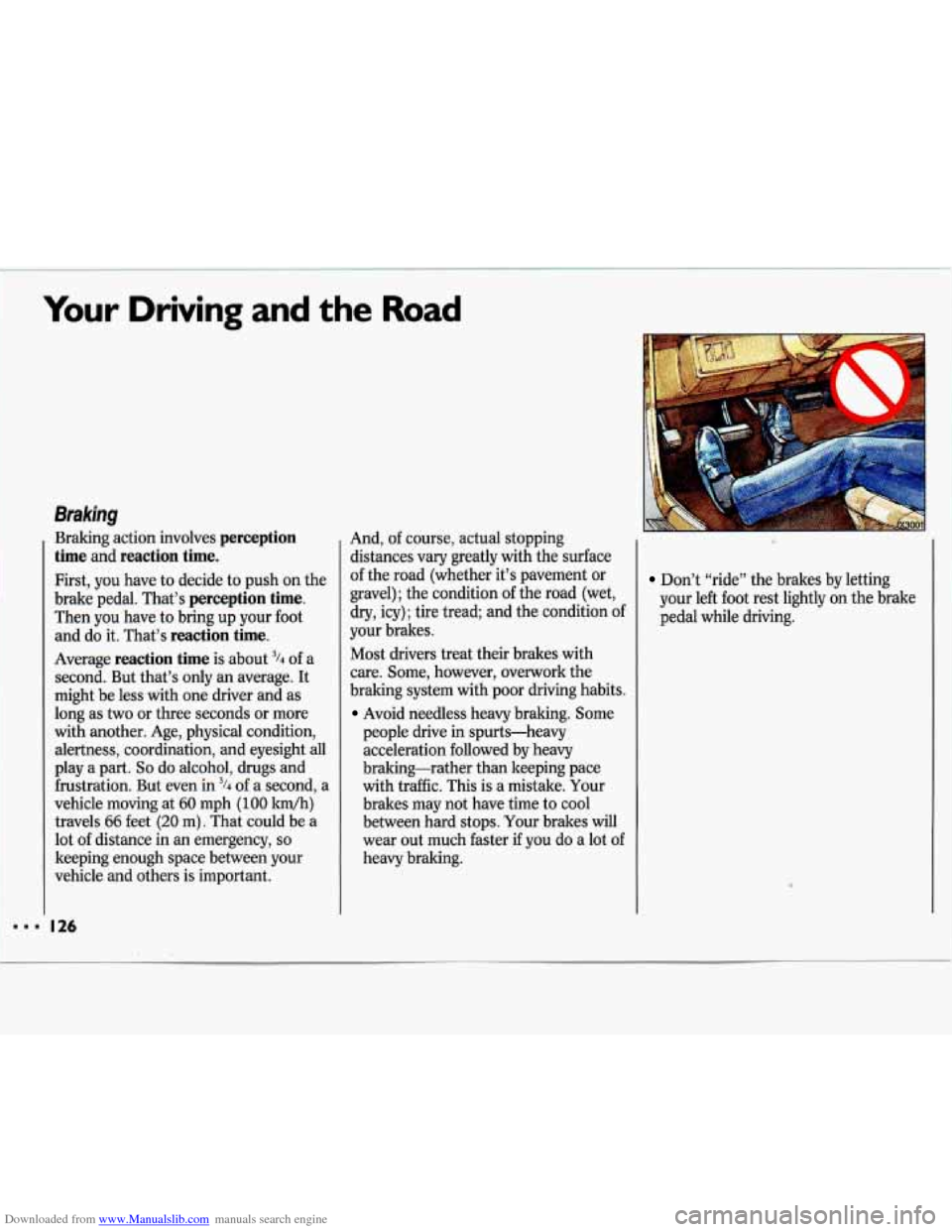
Downloaded from www.Manualslib.com manuals search engine Your Driving and the Road
Braking
Braking action involves perception
time and reaction time.
First, you have to decide to push on the
brake pedal. That’s
perception time.
Then you have to bring up your foot
and do it. That’s
reaction time.
Average reaction time is about 3/4 of a
second. But that’s only an average. It
might be less with one driver and as
long as two or three seconds or more
with another. Age, physical condition,
alertness, coordination, and eyesight all
play a part.
So do alcohol, drugs and
frustration. But even in
’14 of a second, a
vehicle moving at
60 mph (100 km/h)
travels
66 feet (20 m). That could be a
lot of distance in an emergency,
so
keeping enough space between your
vehicle and others is important.
I26
And, of course, actual stopping
distances
vary greatly with the surface
of the road (whether it’s pavement or
gravel); the condition
of the road (wet,
dry, icy); tire tread; and the condition
of
your brakes.
Most drivers treat their brakes with
care. Some, however, overwork the
braking system with poor driving habits.
Avoid needless heavy braking. Some
people drive in spurts-heavy
acceleration followed by heavy
braking-rather than keeping pace
with traffic. This is a mistake. Your
brakes mav not have time to cool
I
between hkd stops. Your brakes will
wear out much faster
if you do a lot of
heavy braking.
Don’t “ride” the brakes by letting
your left foot rest lightly on the brake
pedal while driving.